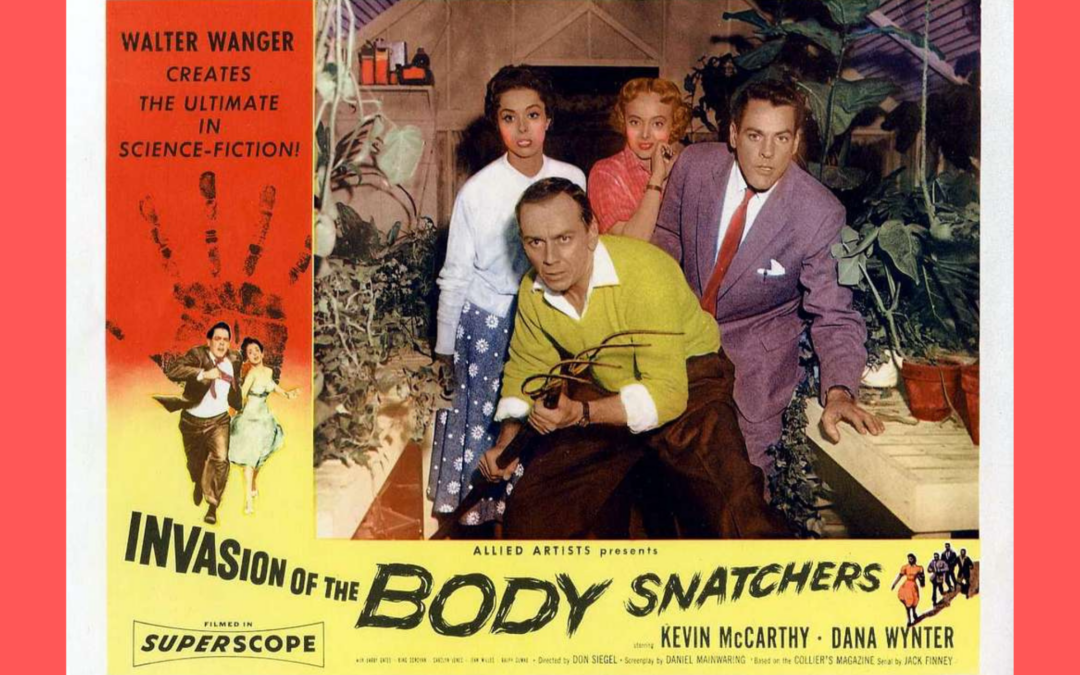Invasion of the Body Snatchers and the Socio-Politics of the 1950s
This is the fifth installment in Mr. Campbell’s series: Homeschooling Through Black and White Film.
The Golden Age of Science Fiction
Many consider the 1950s to be the golden age of science fiction filmmaking. The advent of nuclear technology and the burgeoning space race provided fertile fields for the imagination of science fiction writers. Their novels, pulp serials, and movies dominated American pop culture in the post-war generation. Films of space invaders, alien crafts, and strange contagions filled the big screen while American youth consumed a steady diet of sci-fi comics like Flash Gordon and Weird Science. It seemed that people couldn’t get enough of the genre.
One of the great sci-fi films of the age was Invasion of the Body Snatchers (1956). Directed by Walter Wanger with Kevin McCarthy and Dana Wynter in the starring roles, Invasion of the Body Snatchers is consistently ranked as one of the best sci-fi films of all time. With its theme of foreign contagion that slowly consumes a community, it straddles the line between science fiction and horror, utilizing a masterful use of suspense that still holds up well almost seventy years later. In this article, I’ll be discussing Invasion of the Body Snatchers, not only as a film, but also as a valuable piece of Americana that offers a glimpse into the psyche of the 1950s.
Plot Overview: Fear Comes to Santa Mira
Invasion of the Body Snatchers takes place in the small town of Santa Mira, California. Our protagonist, Dr. Miles Bennel (Kevin McCarthy), returns from a business trip to find an unusual number of Santa Mira’s residents are suffering from Capgras delusion—the delusion that an impostor has replaced a friend, spouse, parent, or someone close. At first, Dr. Bennel thinks the townsfolk are suffering from some kind of social hysteria. Still, he suspects something more sinister when he and his romantic interest, Becky, are called to some friends’ house, where they discover a strange body. The body has no features and no individuality, not even fingerprints. It appears to be growing as a duplicate to replace someone else.
When Dr. Bennel finds another duplicate growing in Becky’s basement (of Becky herself), he becomes sure he is dealing with some foreign entity that is attempting a malicious takeover of the town. His suspicions are confirmed when he realizes that an increasing number of townspeople are different, exhibiting no emotion or intensity. Those who have been “taken” are wiped clean of their humanity. They retain the appearance and memories of their hosts, but are devoid of any distinguishing personality.
Gradually, Bennel and Becky become the only two people in Santa Mira who have resisted having their bodies “snatched.” They discover that this is accomplished through the planting of alien “pods,” which in turn hatch the duplicates that absorb their victims’ minds while they sleep. Bennel and Becky attempt to flee Santa Mira. Bennel escapes, but Becky is lost when she falls asleep momentarily, and her mind is absorbed.
Dr. Bennel makes it to a neighboring town in time to alert the authorities just as the alien impostors begin the process of shipping pods to the neighboring cities to inaugurate the broader takeover of the planet.
The Socio-Political Subtext: Paranoia and Conformity
The interesting thing about Invasion of the Body Snatchers is how much political subtext has been read into it, despite the fact that everyone associated with the project has steadfastly denied that the film has any underlying political messaging. Deiberate or not, the film’s theme of a mind-altering contagion that steals people’s individuality resonated deeply with Americans in the 1950s, highlighting contemporary anxieties about the Cold War.
On one hand, many took the theme of neighbors being part of a clandestine contagion bent on overthrowing society and replacing it with a centralized, deracinated version of humanity as an allegory for the threat posed by Communist ideology. On the other hand, many assumed the alien impostors who relieved man of the burden of individual thought represented the McCarthyites, considered by some as a cabal within the government bent on rooting out personal opinion in favor of rigid political orthodoxy.
If we are to believe director Walter Wagner and all the actors involved, there was never a political subtext. Everyone was merely trying to make a compelling science fiction film. Even so, movies often resonate for cultural reasons that are often beyond the filmmakers’ intent. Whether one sees Invasion of the Body Snatchers as an expression of alarm about Communism or a condemnation of the McCarthyite movement, Americans were clearly concerned about the loss of individuality, groupthink, and the erasure of all that makes us human.
These concerns, already expressed in the 1950s, are even more pressing today, when we are often unsure whether we are communicating with humans or AI-managed bots.
Why Watch It in Black and White
I recommend watching the original black-and-white version, and not a colorized remake. The film’s stark black-and-white cinematography isn’t simply a limitation of the time. It was purposefully shot in SuperScope to create shadowy contrasts and sharp lighting that evoke an atmosphere of paranoia and moral tension, which color simply cannot reproduce. This was a typical film noir style of the 1940s and ’50s.
In a historical context, this choice becomes part of the lesson itself. It serves as a reminder that film is both an art form and an artifact, reflecting the socio-politics, aesthetics, and storytelling conventions of its time. Watching the black-and-white original allows students to step into that world rather than view it through the artificial lens of colorization.
A Classic Worth Revisiting
I found Invasion of the Body Snatchers to be a crisp, compelling film that absolutely merits revisiting. The screenplay is tight, and the plot moves along swiftly. It’s even accessible for younger viewers. My Gen-Z daughter wandered in while I was watching it, sat down, and watched the entire film with me, thoroughly enjoying it.
Invasion of the Body Snatchers is interesting on many levels. As an example of the sci-fi genre at its mid-century apex, this serves as a commentary on the importance of our shared humanity. It is also a warning about the ever-present dangers posed by agents or technologies that would deprive us of that humanity.
If you want a sneak peek into the 1950s, I highly recommend watching this film in conjunction with your homeschool modern history lessons. It’s a fascinating insight into the heyday of science fiction filmmaking and storytelling. It’s sure to instigate a lively discussion around the popcorn popper.
Do you have a favorite black-and-white film that you’ve shared with your homeschooled children? Join me and other homeschooling parents at our Homeschool Connections Community or our Facebook group to continue the discussion!






